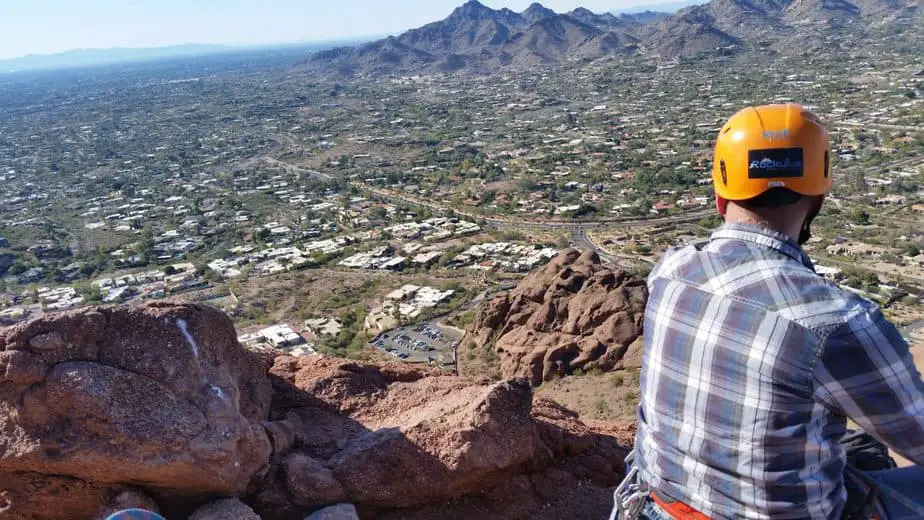Anything can happen at any time. Most risks can be mitigated by practicing safe techniques, but not all. A helmet is a simple example of an extra piece of gear that, while isn’t crucial to climb, adds an extra level of protection in the backcountry. I am firmly in the helmet category, and use a helmet for the vast majority of my climbing.
Helmets protect climbers from rocks and gear falling on them as well as from falling themselves. Most climbers tend to wear helmets for ice climbing, trad climbing, and mountaineering, but not for bouldering or indoor climbing. Sport climbing remains mixed, though helmets are becoming more and more popular.
Climbing helmets have come a long way from when they first started as a plastic ‘brain bucket.’ Modern helmets are made of various materials and are designed to fit and protect the top, sides, and back of your head while still fitting comfortably and being breathable. Contrary to what your significant other might say, rocks are harder than your skull!
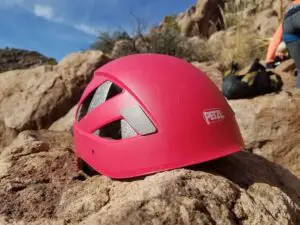
What Types of Climbers Wear Helmets?
Certain types of climbing have different risk levels. In general, ice climbing and mountaineering are more dangerous than trad climbing and sport climbing. We tend to see helmet use increase with the more dangerous types of rock climbing.
For other similar activities like canyoneering and caving, the vast majority of people wear helmets. The stigma built into rock climbing doesn’t really exist in caving and canyoneering.
Helmets are very standard those who do ice climbing, primarily because of the high risk of falling ice and snow. Mountaineering also has high helmet-usage because of the risk of falls and falling rock and ice. Trad climbing generally involves a higher risk of falls and is practiced on rock that isn’t as clean, so there is usually a higher risk of falling rock.
Helmet usage drops significantly for top roping and sport climbing, and is virtually nonexistent for gym climbing and bouldering. A study done by Kevin Soleil investigated the many factors that contribute to the decision of whether or not to wear a helmet. Some of these factors included: perception from peers, training/background, angle of climb, rock quality, difficulty of route, remoteness, and weather conditions.
“Increased helmet use was also associated with age, experience and marginally with incident experience. Decreased helmet use was associated with negative attitudes, values and beliefs as well as indoor learning environments.” (Soleil, 2012, p. 70)
Climbers who had witnessed an injury in the past were more likely to wear helmets, as were those who had been climbing a long time and had children and families. Climbers who climbed more difficult routes were less likely to wear helmets.
Additionally, climbers were less likely to wear helmets on overhung sport routes, especially when top roping. Helmet usage was also lower in areas where the rock quality is higher, which means climbers may be taking rock quality and the likelihood of falling rock into account when making the helmet decision.
The biggest factor contributing to someone wearing a helmet was what their peers did. If someone climbs with a group of friends who all wear helmets, they are much more likely to wear a helmet as well. The same is true in reverse- if your friends don’t wear helmets, you probably won’t either.
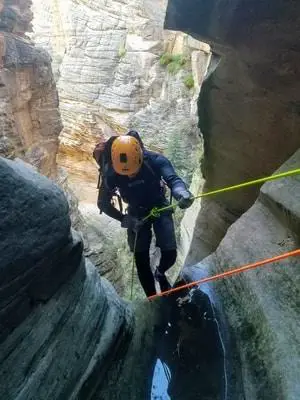
Do Professionals Wear Helmets?
Historically, no one wore helmets when climbing- or really doing any sporting event. As helmets have debuted in cycling, mountain biking, skiing, rock climbing, etc., they tend to be viewed initially as nerdy, cumbersome, and unnecessary.
Over time they have gained more popularity and eventually cross a threshold to where helmet-users are not looked down on. This has clearly happened in cycling and mountain biking (when was the last time you saw a mountain biker not wearing a helmet?).
One thing that could help increase helmet usage among climbers is for media to do a better job portraying climbers in helmets. The belief that climbing helmets aren’t ‘cool’ will likely continue as long as the media continues to show famous climbers not wearing helmets (although what’s the point of a helmet if you are Free Soloing? ).
).
Some of the most famous climbers in the world, including Alex Honnold, Chris Sharma, and even Adam Ondra, don’t usually wear helmets for their preferred styles of climbing. In fact, Alex Honnold tells a story in his autobiography about showing up for some expedition-style big wall climbing without even bringing a helmet along.
about showing up for some expedition-style big wall climbing without even bringing a helmet along.
Sharma and Ondra do a lot of really difficult overhung routes where the risk of rockfall or hitting the wall is lower. We never see helmets in indoor climbing competitions, which erroneously leads to the idea that professionals don’t wear helmets.
Many climbing movies from Reel Rock, as well as the more famous film “The Dawn Wall ,” do show famous and professional climbers wearing helmets. They seem to make similar calculations to the rest of us, wearing helmets on some occasions and not on others.
,” do show famous and professional climbers wearing helmets. They seem to make similar calculations to the rest of us, wearing helmets on some occasions and not on others.
Why Wear a Helmet Rock Climbing?
Rock climbing is all about managing risks. Over time, many of these risks have been reduced thanks to developments in technique and technology. For example, no one does a hip belay anymore, and even tubular-style belay devices are slowly being replaced by assisted braking devices like the GriGri or Birdie . With rock climbing however, some risks are inherent and unavoidable- rockfall sitting at the top of the list for outdoor climbing.
. With rock climbing however, some risks are inherent and unavoidable- rockfall sitting at the top of the list for outdoor climbing.
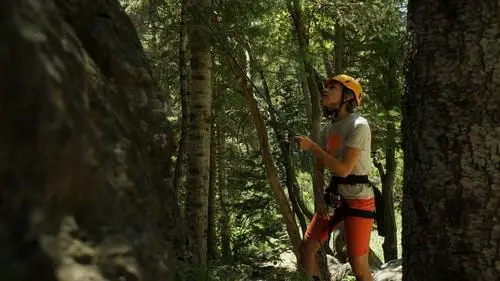
Common Injuries
If you are hit by any rock larger than a microwave, you are pretty much out of luck. For smaller rocks though, a helmet can mean the difference between life and death- or at least traumatic brain injury. Common head injuries for climbers include lacerations, skull fractures, and concussions.
There’s been a lot of research and news coverage lately about the risk of repetitive head injuries. Concussions happen when your brain moves around inside your skull. Repeated brain injuries can lead to diseases like CTE and result in death (cdc.gov ). Even the $300-400 helmets American Football players wear don’t protect fully against concussions and brain injuries, but they certainly help more than the old leather ones!
). Even the $300-400 helmets American Football players wear don’t protect fully against concussions and brain injuries, but they certainly help more than the old leather ones!
There are two main situations where head injuries occur when climbing. The first, as mentioned above, is from rockfall. The constant freezing and thawing of rocks every year leads to small cracks that eventually break off. Some types of rocks are harder than others, and some tend to be more ‘chossy’ or crumbly.
On chossy routes, the lead climber may dislodge several rocks on the way up that come plummeting down towards the belayer. On a normal day at the crag here in Arizona, I tend to hear “ROCK!!!” multiple times.
The other main situation where a head injury is common is when climbers fall and flip upside down. This is very uncommon when top-roping, but does happen occasionally and accidentally when lead climbing- especially when climbing an overhung route or traversing.
Climbers should always watch their feet and be careful not to cross the rope. This can also happen when a harness doesn’t fit well and is too big, or if the climber ties into the wrong point on a harness.
Helmet Testimonials
Talk to a group of climbers at any crag in the world, and someone will have a story about a narrow miss or a time when a helmet saved them from an injury. Petzl has a section of their website devoted to helmet testimonials, which can be submitted with an email to helmetsmatter@petzl.com. If you’re looking to be scared into wearing a helmet, just look up the hashtag #helmetsmatter on instagram.
The bottom line is that, while helmets aren’t a perfect protection 100% of the time, they are safer than not wearing a helmet, 100% of the time. There’s really no good reason not to wear one, though there are several reasons people cite.
Why Don’t Climbers Wear Helmets?
There are lots of different reasons people cite for not wearing a helmet, the most common being that it ruins the aesthetic and the ‘vibe’ of rock climbing. Many say that they are pursuing the freedom promised by rock climbing, and an uncomfortable helmet gets in the way. Helmets have come a long way, but they will always be more bulky and less breathable than not wearing a helmet.
Non-helmet wearers always point to conditions at the crag, stating that the rock quality isn’t that bad, and that no one is climbing above them. They say that the routes have been climbed enough that they’re clean and there won’t be any falling debris.
Some of them point out that you can’t get quite as close to the wall while wearing a helmet so your balance could be affected, or that in extremely narrow crack climbs a bulky helmet doesn’t fit well. The craziest excuse I’ve heard is that you could get caught by your helmet in a fall and strangle on the neck straps!
A lot of the time climbers justify not using a helmet by pointing out that the helmet does very little to cover the back or sides of your head where you would hit if you fell upside-down. While modern helmets do go farther down the back of the skull and attempt to cover more of the sides of the head than they used to, there is still the potential for traumatic brain injury.
Another excuse that doesn’t really hold water to me is the idea that we take higher risks when wearing helmets because of the illusion that we are safer. This theory is called risk homeostasis. While this may slightly affect the instances where a falling climber flips upside-down and hits the wall, it has no affect on the more common event of a rockfall.

The decision of whether or not to wear a helmet usually comes down to whether you were taught to climb by someone or a group who wore helmets, and whether the people you climb with now wear helmets. According to Soleil, “Peer helmet use had the largest correlation to helmet use of any factor in the study” (Soleil, 2012, p. 57). Climbers give a lot of excuses for not wearing helmets, but according to the study a lot of it just comes down to old-fashioned peer pressure.
Do Climbing Helmets Work?
There’s no conclusive proof that helmets ‘work,’ but that’s because it’s impossible to study. No emergency situation is the same and there’s no way to run trials hitting people on the head with and without a helmet.
There are tons of anecdotes of people saying ‘it’s a good thing I was wearing a helmet or else…’ but there’s really no way to know what would have happened if someone had or hadn’t been wearing a helmet.
The UIAA and CE certifying organizations confirm that helmets (and other climbing gear) meet certain standards. The tests that they do for helmets include dropping a 5kg weight on the top of the helmet from 2m up and measuring the force generated on the dummy’s neck. In order to pass the more stringent test (UIAA), it can’t exceed 8 kilonewtons.
They also do a penetration test, which drops a pointed weight from the same height. The helmet passes if the point doesn’t make it to the head underneath. There are several other tests, including dropping weights on the front and back of the helmet to measure stability. (https://www.theuiaa.org/safety-standards/)
For more information on how gear testing and kilonewtons relate to climbing, read my article: How Much Weight Can a Quickdraw Hold?
Climbing helmets are mostly single-use, and should be replaced if you take a hard fall or rock. Think of it like a core shot to your climbing rope. Otherwise, they’ll last several years before they need to be replaced. Climbing helmets won’t protect you from every possible incident, but they do a better job than your beanie or stocking cap does.
How Should a Climbing Helmet Fit?
It’s important that a climbing helmet fits securely on your head or else it won’t do much good. Many helmets have an adjustable harness that can tighten or loosen depending on the size of the head of the climber. It should be snug enough that you can bend over and shake your head side to side without it moving around very much.
Pay specific attention to your ‘Gorby Gap:’ the amount of forehead that is showing. Helmets tend to shift backwards on the head when a belayer or climber is looking up (which we do a lot of!). I
t should be tight enough that the helmet stays put on your head when looking around even when unbuckled. Make sure the chin strap is tight enough that it won’t shift up around your mouth if you fell upside-down.

The most important thing is for it to be comfortable enough that you will wear it. A helmet that sits in your garage or in your bag because it’s uncomfortable is no good to anyone.
Types of Climbing Helmets
We’ve come a long way since wearing wool caps or construction-style hard hats at the crag. Modern helmets are well-ventilated, light weight, and (almost) comfortable. There are three main kinds of climbing helmet on the market today, hard shell, foam shell, and hybrid helmets.
Hard Shell Climbing Helmets
Hard shell helmets are the closest connected with the past. They usually have a webbing harness around your head that keeps the hard shell away from it. They are usually cheaper than other options, but don’t fit as well or cover as much of the head (especially the back and sides).
Lots of climbers use a hard shell helmet as the spare helmet they share with non-climbers or visitors because they are easily adjustable, are cheap, and are very durable with everyday bumps and scrapes.
The downside to hard shell helmets is they don’t breathe as well, they don’t really look as sharp, they are usually a bit heavier, and they aren’t as comfortable. Hard Shell helmets are more common for caving and canyoneering, where you are expected to hit your head on stuff more frequently. Some examples include the Liberty Mountain Combi and the Black Diamond Half Dome
and the Black Diamond Half Dome (click to view on Amazon).
(click to view on Amazon).
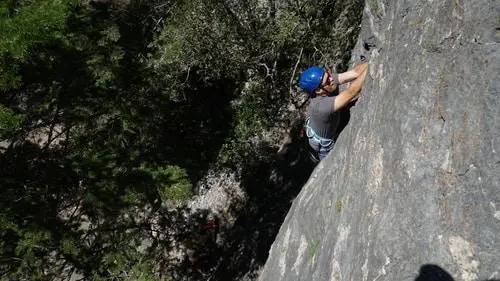
Foam Climbing Helmets
These climbing helmets primarily use foam instead of hard plastic to ward off bumps and rocks. Many do have a thin layer of plastic (like a bicycle helmet) on the outside as well.
Like a bike helmet, they should be discarded and replaced after a single bad incident because the foam crumples and is compromised. Foam helmets are usually more expensive, but breathe better, fit better, and are somewhat more comfortable.

Examples include the Black Diamond Vapor and Black Diamond Vector
and Black Diamond Vector (click to view on Amazon).
(click to view on Amazon).
Hybrid Helmet
The vast majority of climbing helmets today use a combination of the hard shell and foam hybrid. The hard shell protects the foam from smaller bumps, and the foam helps with comfort and safety from a big incident. Over time, most manufacturers have changed their hard shell models to incorporate foam into the designs for added safety and comfort.

One of the best examples is the Petzl Sirocco (view on Amazon) with it’s hard plastic top and foam sides.
(view on Amazon) with it’s hard plastic top and foam sides.
Other features in climbing helmets
When picking a helmet, I recommend getting one that has a way to secure a headlamp to it. Many have simple little clips that hold a headlamp in the event that you get stuck overnight on a multipitch climb or going through a canyon at night.
There are women’s specific models that fit ponytails better as well, and all of the colors you can imagine. Get a helmet that is big enough to incorporate a warm hat underneath as well for climbing in cooler weather.
Related Questions:
Can you use a Bike Helmet for Rock Climbing? Bike helmets and rock climbing helmets are designed for different impacts and purposes; however, using a bike helmet for rock climbing is better than not using any helmet at all. A bike helmet that fits well still provides some protection to the top of the head, and a mountain bike helmet covers more of the back of the skull as well.
How Long do Climbing Helmets Last? Climbing helmets can last as long as 10 years if they remain undamaged. Hardshell helmets can handle repeated smaller hits, while foam shell helmets are less durable. Any helmet should be replaced after a big hit because it compromises the foam protection.
Foam vs Hardshell Climbing Helmets? Foam helmets are more comfortable, lighter weight, and breathe better, while hardshell helmets are more durable and cheaper. Hybrid helmets comprised of a hard outer shell covering a foam layer provide the best of both styles of helmet and are more and more common.

Sources:
Soleil, Kevin Henri Hogan, “Helmet Use Among Outdoor Recreational Rock Climbers Across Disciplines: Factors of Use and Nonuse.. ” Master’s Thesis, University of Tennessee, 2012.
https://trace.tennessee.edu/utk_gradthes/1263
CDC, https://www.cdc.gov/traumaticbraininjury/outcomes.html
UIAA Safety Standards, https://www.theuiaa.org/safety-standards/

